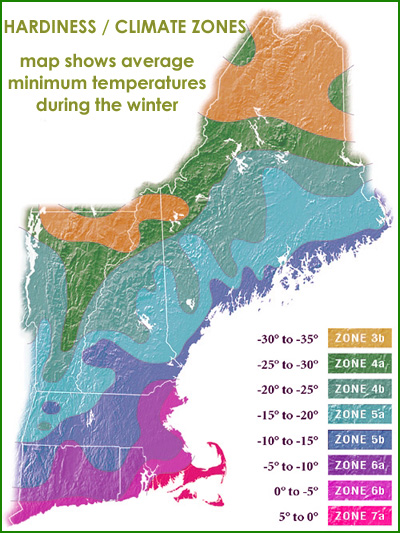Know Your Hardiness Zone Before Choosing Your Plants in Your New England Garden
Last Updated:
What is a Hardiness or Climate Zone?
I think we'd all agree that the climate is much different on Cape Cod than it is on the top of Mt. Washington in New Hampshire, right? Over thousands of years, plants have acclimated to withstand certain temperature lows and still survive. In other words, the plants that you will see growing wild on a mountain top are quite different from those you'll find in a southern Connecticut valley. Each plant has a hardiness zone rating, ranging from 1 to 11 in the United States, with the lower numbers being able to tolerate the lowest temperatures.

Because we can purchase plants from all over the world from different climates, it is critical to pick plants that can handle the worst winter temperatures and still survive to grow the following year. If you plant only annuals, that is, plants that go to seed and have to be planted from seed each year, the only concern you have is making sure you plant the seeds/plants after all danger of frost has passed each year. But for bulbs, roots and other perennial plants that shed their leaves but stay alive through the winter, make sure you know your climate/hardiness zone and pick plants that can survive those temperatures from year to year.
In many parts of the country, the hardiness zone doesn't vary too much, maybe 10 or 15 degrees as the minimum temperature each winter. But here in New England, the effects of the Atlantic Ocean on coastal New England along with the altitude of the mountains makes our zones range from 3 in the mountainous north to a balmy 7a in the southern coastal plains. This wide range of minimum temperatures means the growing conditions are quite different from place to place. In addition, you should consider microclimates as well, meaning a south-facing garden sheltered from the wind may support plants beyond the normal hardiness zone range. So do your homework and get gardening!
Important United States Zone Map Update
I think we've all heard about climate change by now. It has already had a tremendous effect on the growing season here in New England. Areas that used to be zone 4, are now zone 5 and zone 6 (much warmer). Believe it or not, areas of south coastal Rhode Island and Cape Cod are now in zone 7. That's the same zone as parts of the Carolinas, Georgia, and even Mississipi. You can always see the latest USDA Map online here: >>Latest USDA Interactive Hardiness Zone Map